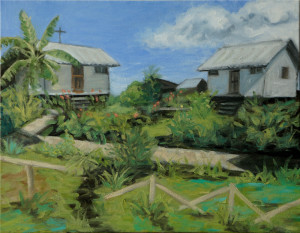 I have completed a series of paintings dedicated to the 918 people who lost their lives in Jonestown, the survivors who had to pick up the pieces of their own lives and go on, and to the families and friends who lived through it all with them.
I have completed a series of paintings dedicated to the 918 people who lost their lives in Jonestown, the survivors who had to pick up the pieces of their own lives and go on, and to the families and friends who lived through it all with them.
The sign said “Welcome to Jonestown Peoples Temple Agricultural Project.” For these paintings, I chose to focus on the “Agricultural Project” aspect of that sign, and on what a group of people built instead of what some of them eventually destroyed. I wanted to paint the life of the place instead of its death. The name “Jonestown” has so many negative and complex connotations that I wanted it to recess into the background in these works. As a result, the series focuses primarily on the structures and natural beauty of Jonestown, depicting its cottages, buildings, fields and gardens, playground and surrounding jungle which I feel represent the vision and hard work of the people who went to Guyana with a dream and a desire for something more.
When I first started these paintings I had no idea how large and comprehensive Jonestown actually was. It was not only quite a surprise to me especially when viewed from the air but also very impressive to see what could be carved out of the jungle. As I viewed more photos and painted more scenes and elements of the area, I felt that I had some sense and understanding about what the builders and creators of this place were striving for. I also felt what it might have been like to live and work there, at least in regard to the surrounding environment. It was very apparent that much thought and care was given to even the smallest detail, something I had not expected to see before doing the research for these paintings. I believe all this research was necessary before I could try to convey what I felt would represent Jonestown structurally and what would also represent the passion of the people building it. As I created this series, I thought more about the people of Jonestown and not their leader. I was more interested in how they created this place from nothing and what their daily lives might have been like first and foremost, especially during the time before Jim Jones made his final move to Guyana.
Originally I was planning to paint the essence of Jonestown in more of an abstract style, but as I did more research, I realized that I was much more interested in representing the actual “town.” I wanted the viewer to get more of an idea of what it physically encompassed and the planning that seemed to go into it because I don’t think that is what first comes into most people’s minds when they think about Jonestown. I know that I had never thought about it in that way before I started these paintings. I also wanted the paintings to be devoid of people because I wanted to respect their privacy. This was a group of people that to my knowledge never wanted to be in the spotlight once they made the move to Guyana.
I hope to exhibit these paintings and bring a whole new audience to a sense of what it might have been like to live and work in Jonestown and what it must have taken to make the vision of its inhabitants come true, if even for a short time.
(T. Gordon has completed a painting series depicting Jonestown. The author’s article in last year’s edition of the jonestown report was Summer Camp.)